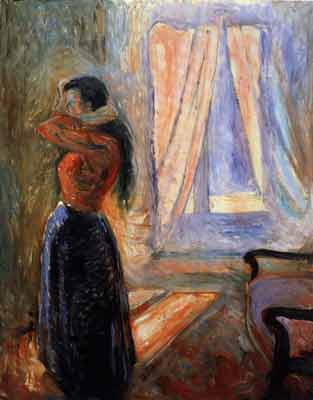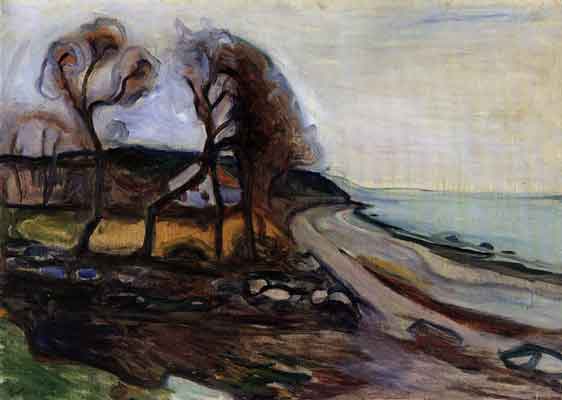 |
Femme á sa toilette, 1892.
Oil on canvas, 35 1/8" x 28 9/16".
Edvard Munch: Paintings 1892-1917by Donald Goddard |
Femme á sa toilette, 1892. Oil on canvas, 35 1/8" x 28 9/16". |
More stylistic and expressionistic tendencies
intersect in Edvard Munch's art than that of any other artist of the modern era.
Like the Symbolists--Delville, Böcklin, Degouve de Nunques, and others--he
often cast his dramas of life and death in metaphoric terms. Like Gauguin, Denis,
Bernard, and Hodler he created rhythmic and symmetric decorative schemes of line
and color to contain those metaphors. In early works he improved on the insistent
realism of his teacher Christian Krohg, then lightened his palette like the Impressionists
after visits to Paris in 1890 and 1891. He wove webs of sinuous line like Henri
de Toulouse Lautrec and the practitioners of Art Nouveau and became the most
important precursor of Expressionism in Germany and elsewhere. He also frequented
cafes and cabarets, like most Bohemians, though perhaps less light-heartedly
than others.
|
|
But strangely, and unlike other artists, Munch discarded none of these aspects of the art and milieu of the time. Nothing was lost, neither Realism, nor Impressionism, nor Symbolism, nor Art Nouveau. He is, in a sense, more like the playwrights Henrik Ibsen and August Strindberg, both of whom he knew and worked with, and Anton Chekhov. Everything in his work is characters, sets, and drama; nothing of the kind exists in anyone else's art. We are accustomed, at least in my generation, to think of Western modern (or "modernist") art beginning in 1905 with Fauvism and Expressionism and in 1907 with Cubism--essentially with Matisse and Picasso. The evolution then continues in various forms of abstracting or abstraction through Futurism, Orphism, Suprematism, Constructivism, Neo-Plasticism, Dada, Surrealism, and Abstract Expressionism, finally to break down (in the U.S.) through Pop Art, Minimalism, Pluralism, Neo-Expressionism, and Post-Modernism. As a method of intellectual and commercial selection this structure does not necessarily exclude certain artists though it may distort their achievement. And when the structure is questioned, as it is currently by curators and others, it is simply replaced by another structure, one that is more "open." |
|
But strangely, and unlike other artists, Munch discarded none of these aspects of the art and milieu of the time. Nothing was lost, neither realism, nor Impressionism, nor Symbolism, nor Art Nouveau. He is, in a sense, more like the playwrights Henrik Ibsen and August Strindberg, both of whom he knew and worked with, and Anton Chekhov. Everything in his work is characters, sets, and drama; nothing of the kind exists in anyone else's art. We are accustomed, at least in my generation, to think of Western modern (or "modernist") art beginning in 1905 with Fauvism and Expressionism and in 1907 with Cubism--essentially with Matisse and Picasso. The evolution then continues in various forms of abstracting or abstraction through Futurism, Orphism, Suprematism, Constructivism, Neo-Plasticism, Dada, Surrealism, and Abstract Expressionism, finally to break down (in the U.S.) through Pop Art, Minimalism, Pluralism, Neo-Expressionism, and Post-Modernism. As a method of intellectual and commercial selection this structure does not necessarily exclude certain artists though it may distort their achievement. And when the structure is questioned, as it is currently by curators and others, it is simply replaced by another structure, one that is more "open." |
 © Galleri Faurschou By the Shore, 1898-1904. Oil on canvas, 27 3/8" x 39 7/16". |
| In this context, the 1890s represent a prelude, a mock profound prehistory. It is the decade of gaiety, decadence, silly Bohemian life, old-fashioned cabaret acts, the rebellion of artists in groups, the beginning of labor unions, and the last of the horse and carriage--the world from which we come but have long since surpassed, nothing compared to the technological and intellectual advances, the real, serious life of the 20th century, not to speak of its world wars and other important events. Munch is taken seriously, of course, but usually in terms of an idea of fin-de-siécle biological pessimism. The 20th century is the clean century, the century in which things get done, wars are won, great truths are discovered, and Freud is both avowed and disavowed; Munch's place in it is rather marginal. He is a man of the 1890s--murky, despondent, cursed. His place in the 20th century is in the 1890s, as Monet's, for instance, is in the 1870s, not in the world of clean lines, clear colors, and two-dimensional space. But, of course, he lived much of his mature life in the 20th century, and he even seems to belong there. It is true that he did not pay homage to mechanization, nor to the perfectibility of man's aspirations, be they socialist or bourgeois, nor to the transcendence of aesthetic strategies. His guiding principles rather crumbled as he got older, as did his eyesight and the world around him, but he somehow remained indomitable in his work and in what he saw. And his importance as an artist of the 20th century, an artist who used the canvas itself and the painted surface as a means of expression, is underestimated. |
|
Beginning roughly in about 1888 Munch conceived his paintings as parts of a "Frieze of Life," which later included "Love's Awakening," "Love Blossoms and Dies," "Fear of Life," and "Death," and wrote "These paintings are rather hard to understand, but I think it will be easier if they are seen in context--they deal with love and death." The drama is continuous, though interrupted by people in portraits who need to be introduced, just as Munch needs to reintroduce himself as he gets older, until finally he is seen as an old man, bolt upright between his clock and his bed, during the early years of the Nazi occupation of Norway. In that painting of 1940-42, Munch's entire life is compressed within the cramped space of his rooms--a doorway, the clock, the bed, the yellow back wall with paintings on it, his own unmistakable figure in blue pants and jacket, all suspended in verticality. There are no illusions. Everything is paint strokes--mostly vertical, some horizontal, a few diagonal -- to the point that the bedspread is just that, a series of patterned blue and red paint strokes. The canvas shows through; it is the reality. |
|
Munch had long before found that plane of reality, in the 1880s, in such works as The Sick Child of 1885-86, in which hands and other features are barely scumbled in and the canvas is left raw in a number of places as though it too were part of the drama, so that the picture surface itself, in its barely existing thickness, has an undeniable presence in the space of the artist and the viewer. He had discovered something that had to do with how the mind perceives, perhaps through emotional engagement, with vividness and uncertainty at the same time. Roundly criticized in the Norwegian press for his perfunctory execution, Munch described The Sick Child, perhaps defensively, as a "study," placing it in the respectable tradition of oil sketches, which go back at least to Rubens and in which bare canvas and rapid brushstrokes are acceptable. Munch, of course, was doing much more than that. Despite his protestations, he was making finished paintings, with the caveat that no painting can be complete in itself, only part of a continuum. It has been demonstrated that Munch used thinned-down paint to achieve the expression he wanted only after 1900, but the effects were there much earlier, by the mid-1880s, when he was in his early twenties. Other artists, including Gauguin, Cézanne, Vuillard, Toulouse-Lautrec, and certainly the Cubists later on, did something similar, allowing the canvas to show through and freeing colors and brushstrokes from strict representation. But Munch's motives were different. He was most like Cézanne, perhaps, in that he desperately wanted to realize the essence of his subjects while feeling inadequate to the task, though Munch's approach is more emotional and psychodramatic. What he sees and feels is woven directly into the canvas; it is part of the canvas. This is true even when the canvas is completely covered with paint. Skeins of color are swirled together in a pattern that represents the scene and his emotive idea of the scene, just as Cubism creates a structure that evokes both scene and idea. Everything is on the surface, part of the same fabric, including the impossibly distant moon. |
Vampire, 1917. Oil on canvas, 33 1/2" x 43 5/16". |
|
The paintings in this exhibition are from private collections in Europe. Eight of the nine date from 1892 to 1906 (the ninth, The Vampire, is from 1917), when Munch first subsumed his work under "The Frieze of Life." In his exhibitions of this name--seen in Berlin, Leipzig, Copenhagen, Kristiania (Oslo), and Prague--the paintings were not always the same, though he did produce two distinctive series under the title for two different patrons, the German eye specialist Dr. Max Linde in 1904-08 and the great Berlin theater impresario Max Reinhardt in 1906-07. In this exhibition, the great themes of his frieze are missing, of the deaths in his family, of seduction and disappointment in love. It's alright. The settings are there, and Munch's affection for and attachment to them are amazing. Figures, rocks, skies, water, trees, light, houses are all animated with the same spirit, occasionally in the form of childish exaggeration, as, for instance, in Mystery of the Beach, 1892, a white form in the lower right appears with a smiling ghostlike face, and in Fertility, 1894, the man's hat merges with the hills in the distance. But even in their ridiculousness, these details indicate the extent to which Munch identifies with the places. Two of the works--Femme à sa toilette and Winter Morning--were painted in 1892 after his earlier stays in Paris and show Munch's interest in Impressionism. Most of the rest seem to derive from his summers in Asgardstrand on the shore near Kristiania. All have intensely alive fields of vision and some powerful, abstract source of energy that forces them into life. In Femme à sa toilette it is the blast of light through the window that transfixes everything in the room. In Winter Morning it is the clash of geometry and chaos, light and rain. In Mystery of the Beach it is the emergence of bulging shapes that reveal the raw canvas against a dark sea. And in others it is the constant flow of line that ties figures to landscape and each other, trees to sky, and shores to sea. Where does one thing end and another begin? In the Vampire, the male figure is enshrouded by the woman's arms and long red hair and both are enshrouded by darkness. There is no beginning and end, but the maelstrom of line, light, and color somehow brings things together. Munch sought and understood that universe of confluence, so that with each painting one stands at the edge of something else, as many of his figures stand at the edge of the sea. Donald Goddard © 2001 |
Art Review - NYArtWorld.com - NYAW.com. All artwork is copyright of the respective owner or artist. All other material © Copyright 2015 New York Art World ®. All Rights Reserved.
New York Art World ® - Back to Top